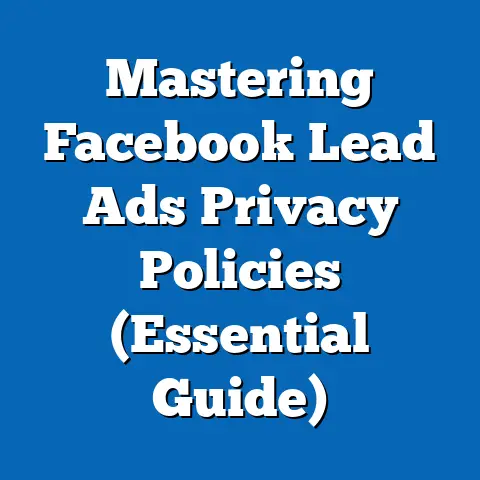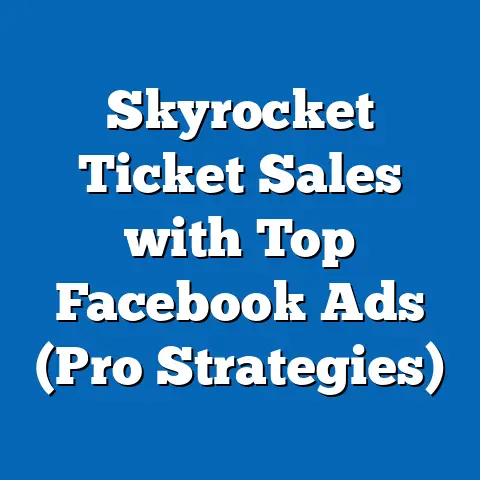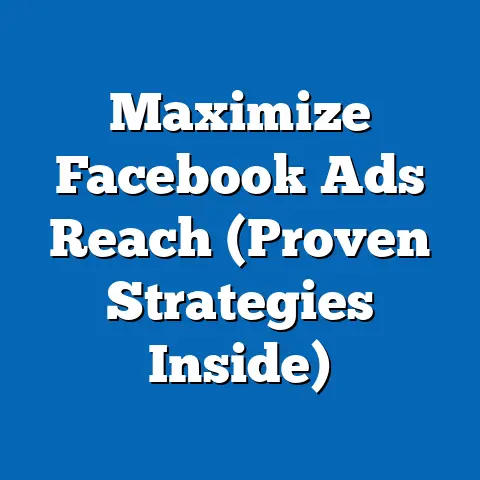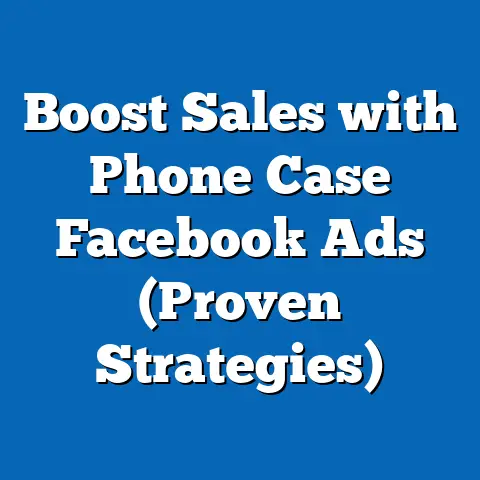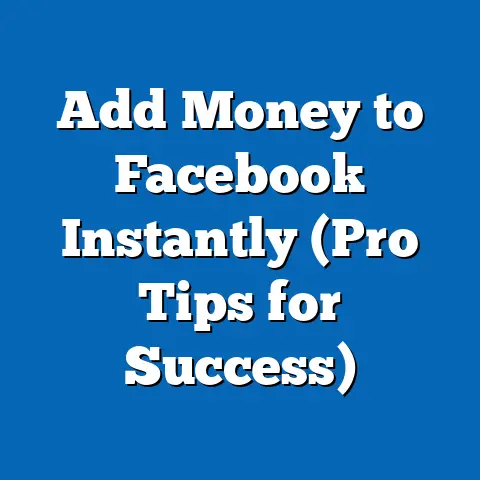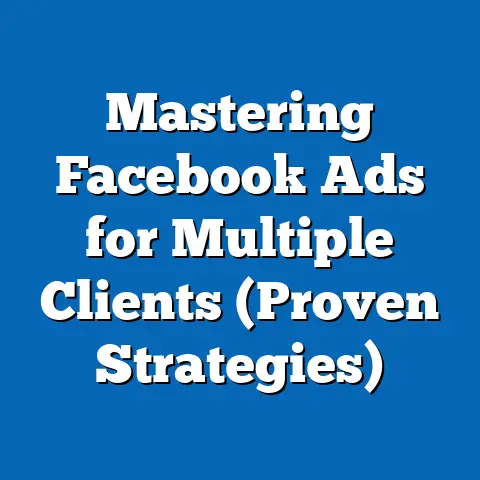Transform Tofu Facebook Ads for Maximum Impact (Pro Strategies)
Imagine a product so unassuming, so often overlooked, that it hides in plain sight on supermarket shelves—yet possesses the potential to captivate millions online. Tofu, a humble staple of plant-based diets, is not just a culinary chameleon; it’s a marketing enigma waiting to be unlocked. In the fast-paced world of digital advertising, where trends shift overnight and consumer attention is a fleeting prize, can tofu—a symbol of simplicity—become a powerhouse on platforms like Facebook?
Section 1: Defining Tofu in the Marketing Landscape
Tofu, often referred to as bean curd, is a soy-based product that originated in China over 2,000 years ago. Its defining characteristics—versatility, nutritional value, and affordability—make it a unique candidate for marketing campaigns targeting diverse audiences. Whether it’s positioned as a meat alternative for vegans, a protein-packed superfood for fitness enthusiasts, or a budget-friendly ingredient for families, tofu’s adaptability is its greatest asset.
However, tofu also carries a perception challenge. Often stereotyped as bland or niche, it struggles to capture the imagination of mainstream consumers in Western markets. This is where strategic Facebook advertising can play a transformative role, reframing tofu as an exciting, accessible, and essential part of modern diets.
From a societal perspective, marketing tofu aligns with broader trends toward sustainability and health-conscious living. With global concerns about climate change and the environmental impact of meat production, plant-based foods are gaining traction across generations. A 2021 report by NielsenIQ found that 43% of global consumers are actively trying to reduce their meat consumption, creating a fertile ground for tofu campaigns to resonate.
Section 2: Historical Context of Tofu and Its Cultural Evolution
Tofu’s journey from ancient China to global kitchens is a story of cultural diffusion and adaptation. Historians trace its origins to the Han Dynasty (206 BCE–220 CE), where it was initially a dietary staple for Buddhist monks adhering to vegetarian principles. Over centuries, tofu spread across Asia, becoming integral to cuisines in Japan, Korea, and Southeast Asia, each region adding its own flavors and preparation methods.
In the West, tofu gained prominence in the 20th century, particularly during the counterculture movements of the 1960s and 1970s. As interest in vegetarianism and Eastern philosophies grew, tofu became a symbol of alternative lifestyles among Baby Boomers. By the 1990s and 2000s, as health and environmental concerns entered mainstream discourse, tofu began to appeal to Gen X and Millennials, often marketed as a functional food rich in protein and low in fat.
Today, tofu stands at a cultural crossroads. For Gen Z, raised in an era of climate activism and social media, tofu represents both a sustainable choice and a canvas for culinary creativity—think viral TikTok recipes featuring tofu scrambles or crispy tofu bites. Understanding this historical and generational context is critical for crafting Facebook ads that resonate with diverse audiences, tapping into nostalgia for older generations and innovation for younger ones.
Section 3: Societal Implications of Promoting Tofu
The push to market tofu through digital platforms like Facebook carries significant societal implications. At its core, promoting plant-based foods challenges the dominance of meat-centric diets, which contribute to approximately 14.5% of global greenhouse gas emissions, according to the Food and Agriculture Organization of the United Nations (FAO). By positioning tofu as a viable alternative, marketers can contribute to a cultural shift toward sustainability—a cause that resonates deeply with younger generations like Millennials and Gen Z, who prioritize eco-conscious brands.
Moreover, tofu campaigns can address public health concerns. With rising rates of obesity, heart disease, and diabetes in many developed nations, plant-based diets are increasingly endorsed by health experts. A 2020 study published in the Journal of the American Medical Association found that diets high in plant-based proteins like tofu are associated with lower risks of cardiovascular issues, offering a compelling hook for health-focused ads.
Yet, there are challenges to consider. Tofu’s cultural associations with niche or “hippie” lifestyles can alienate certain demographics, particularly older or more traditional consumers. Additionally, the soy industry itself faces scrutiny over deforestation and genetically modified crops, issues that could undermine tofu’s “green” image if not addressed transparently in campaigns. Marketers must navigate these complexities to build trust and authenticity.
Section 4: Generational Dynamics in Tofu Marketing
Generational differences play a pivotal role in shaping how tofu is perceived and marketed on platforms like Facebook, which boasts over 2.9 billion monthly active users spanning all age groups. Let’s break down how each generation interacts with tofu and digital advertising, drawing on both qualitative insights and quantitative data.
Baby Boomers (born 1946–1964): For many Boomers, tofu remains a relic of the 1970s counterculture—a curious but not always embraced food. However, as this generation ages, health concerns become a priority, with 60% of Boomers expressing interest in heart-healthy diets, per a 2022 AARP survey. Facebook ads targeting Boomers should emphasize tofu’s nutritional benefits and ease of preparation, using familiar formats like testimonials or recipe videos.
Generation X (born 1965–1980): Gen X, often balancing busy careers and family life, values practicality and affordability. Tofu’s low cost and versatility can appeal to this cohort, but they are also skeptical of marketing hype. Ads for Gen X should focus on quick, family-friendly meal ideas, leveraging nostalgia (e.g., “Remember trying tofu in the ‘90s? Here’s why it’s better now”) while maintaining authenticity.
Millennials (born 1981–1996): As the first digital natives, Millennials are highly active on social media and responsive to purpose-driven brands. With 48% of Millennials identifying as “flexitarian” (reducing but not eliminating meat), according to a 2021 Mintel report, they are a prime audience for tofu campaigns. Ads should highlight sustainability, ethical sourcing, and trendy recipes, using visually engaging content like short-form videos or influencer partnerships.
Generation Z (born 1997–2012): Gen Z, shaped by social media and global crises, prioritizes authenticity, diversity, and environmental impact. They are 27% more likely than older generations to adopt plant-based diets, per a 2023 YouGov poll. For this group, tofu ads should be bold, meme-driven, and interactive—think polls, challenges, or user-generated content campaigns that encourage them to share their own tofu creations.
Understanding these generational nuances ensures that Facebook ads are tailored to specific values and media consumption habits, maximizing engagement across age groups.
Section 5: Technological and Economic Factors in Tofu Advertising
The success of tofu campaigns on Facebook hinges on leveraging technological tools and navigating economic realities. Facebook’s advertising platform offers unparalleled targeting options, from demographic filters to interest-based audiences (e.g., “vegan cooking” or “sustainable living”). Advanced features like Lookalike Audiences and retargeting allow marketers to reach users similar to existing tofu enthusiasts or re-engage those who’ve interacted with plant-based content.
Moreover, the rise of video content on Facebook—where videos account for 50% of time spent on the platform, according to a 2022 Meta report—presents a golden opportunity. Short, visually appealing videos showcasing tofu recipes (e.g., “3-Minute Tofu Stir-Fry”) can capture attention in crowded newsfeeds. Pairing these with shoppable ads or links to e-commerce platforms can drive direct sales, a crucial metric in today’s performance-driven marketing landscape.
Economically, tofu’s low production cost compared to animal proteins offers a competitive edge for brands. However, marketers must contend with fluctuating consumer budgets, especially in inflationary periods. Positioning tofu as a cost-effective protein source—potentially through comparison ads (e.g., “Tofu vs. Chicken: Save More, Eat Better”)—can appeal to price-sensitive consumers across generations.
Section 6: Social and Cultural Factors Shaping Tofu Campaigns
Socially, the growing acceptance of plant-based diets has shifted tofu from a fringe product to a mainstream option. High-profile endorsements from celebrities and athletes, coupled with the rise of movements like Veganuary, have normalized tofu in popular culture. On Facebook, tapping into these trends through influencer collaborations or hashtag campaigns (e.g., #TofuTransformation) can amplify reach and credibility.
Culturally, however, tofu marketing must be sensitive to regional differences. In Asia, where tofu is a dietary staple, ads might focus on innovative flavors or premium varieties to stand out. In Western markets, where familiarity is lower, campaigns should prioritize education—explaining what tofu is, how to cook it, and why it matters. Localization tools on Facebook, such as geo-targeting and language-specific ads, enable brands to tailor messages to cultural contexts.
Diversity within audiences also matters. Tofu’s appeal spans ethnic and socioeconomic lines, but messaging must avoid alienating groups. For instance, ads should showcase tofu in a variety of cuisines—think tofu tacos for Latin American audiences or tofu curry for South Asian communities—ensuring inclusivity and relevance.
Section 7: Pro Strategies for Maximum Impact on Facebook
Now that we’ve explored the context and dynamics of tofu marketing, let’s dive into actionable, pro-level strategies to transform tofu ads on Facebook for maximum impact. These tactics are grounded in data, generational insights, and platform-specific best practices.
1. Craft Compelling Visual Storytelling: Visuals are king on Facebook, where 87% of users engage with image or video content, per a 2023 Sprout Social report. Invest in high-quality images and videos that showcase tofu’s versatility—think vibrant, drool-worthy dishes like crispy tofu nuggets or creamy tofu smoothies. Use before-and-after visuals (e.g., raw tofu transforming into a gourmet meal) to demystify the product and inspire action.
2. Segment Audiences with Precision: Leverage Facebook’s targeting capabilities to segment audiences by age, interests, and behaviors. Create separate ad sets for health-conscious Boomers, budget-focused Gen X, eco-driven Millennials, and trend-savvy Gen Z. Tailor messaging and creative assets to each group’s values, ensuring relevance—e.g., sustainability-focused ads for younger users, health testimonials for older ones.
3. Harness the Power of User-Generated Content (UGC): Encourage fans to share their own tofu recipes or experiences through branded challenges (e.g., “Show Us Your Tofu Twist!”). UGC not only boosts engagement but also builds trust, as 79% of consumers trust peer recommendations over traditional ads, according to a 2022 Nielsen study. Amplify the best submissions through boosted posts or Stories.
4. Optimize for Mobile and Short Attention Spans: With 98% of Facebook users accessing the platform via mobile devices (Meta, 2023), ads must be mobile-first—think vertical videos, bold text overlays, and thumb-stopping visuals. Keep content concise; aim for 15–30-second videos that hook viewers within the first 3 seconds, addressing pain points like “Need a quick dinner idea?” or “Want to eat greener?”
5. Test and Iterate with A/B Testing: Experiment with different ad formats (carousel, video, static images), headlines (“Tofu: Your New Superfood” vs. “Cook Tofu Like a Pro”), and calls-to-action (“Shop Now” vs. “Learn More”). Use Facebook’s split-testing tools to identify high-performing variations, then scale winning campaigns. Data from HubSpot (2023) shows that A/B testing can improve click-through rates by up to 30%.
6. Integrate Social Proof and Influencers: Partner with micro-influencers (10K–100K followers) in the food, fitness, or sustainability niches to showcase tofu in authentic ways. Their endorsements, paired with customer reviews or ratings in ad copy, build credibility. A 2021 Influencer Marketing Hub report found that 63% of consumers trust influencer content over brand ads.
7. Drive Conversions with Retargeting and Funnels: Use Facebook Pixel to track website visitors or past ad engagers, then retarget them with personalized ads (e.g., “Still Thinking About Tofu? Here’s a 10% Off Coupon”). Build a funnel—awareness ads (recipe videos), consideration ads (health benefits), and conversion ads (discounts or shop links)—to guide users from discovery to purchase.
8. Align with Cultural Moments and Trends: Time ads around relevant events like World Vegan Day (November 1), Earth Day, or Meatless Monday campaigns. Tap into trending hashtags or viral challenges to stay relevant, ensuring tofu feels current rather than outdated. Monitor Facebook Insights to identify peak engagement times for scheduling posts.
Section 8: Implications for Society, Culture, and Business
The impact of successful tofu Facebook campaigns extends beyond brand metrics to broader societal, cultural, and business domains. On a societal level, increased tofu consumption driven by effective ads can contribute to reduced meat demand, lowering carbon footprints and supporting global sustainability goals. This aligns with the priorities of younger generations, potentially accelerating cultural acceptance of plant-based diets.
Culturally, well-crafted campaigns can reposition tofu as a staple rather than a specialty item, bridging generational and regional divides. By showcasing diverse recipes and stories, ads can foster inclusivity, encouraging cross-cultural dialogue about food and health. However, marketers must remain vigilant about avoiding cultural appropriation or insensitivity in their messaging.
For businesses, mastering tofu advertising on Facebook offers a blueprint for marketing other niche or misunderstood products. The strategies outlined—segmentation, storytelling, UGC—can be adapted to various industries, from health foods to eco-friendly goods. Moreover, brands that lead in plant-based marketing stand to gain loyalty from values-driven consumers, a growing demographic per a 2023 Deloitte study showing 55% of shoppers prioritize ethical brands.
In the workplace, these campaigns can influence corporate strategies, pushing food companies to invest in digital marketing talent and sustainability initiatives. Partnerships between tofu brands, tech platforms, and influencers may redefine how food marketing operates, prioritizing authenticity and community over traditional mass-media approaches.
Section 9: Conclusion: The Future of Tofu in Digital Advertising
As we’ve explored, tofu is far more than a bland block of soy—it’s a symbol of adaptability, sustainability, and cultural evolution with immense potential in the digital advertising space. Through strategic Facebook campaigns that leverage generational insights, technological tools, and cultural trends, marketers can transform tofu from an underdog to a viral sensation. The pro strategies outlined—visual storytelling, precise targeting, UGC, and beyond—offer a roadmap for maximum impact, grounded in data and consumer behavior.
Looking ahead, the future of tofu marketing on platforms like Facebook remains dynamic and uncertain. Will Gen Z’s climate activism propel plant-based foods to new heights, or will economic pressures and cultural resistance slow adoption? Can advancements in ad tech, such as AI-driven personalization, further refine how tofu reaches niche audiences? These questions linger, but one thing is clear: tofu’s moment in the digital spotlight is just beginning.
By embracing innovation while respecting generational and cultural nuances, marketers have the power to not only boost tofu sales but also contribute to a healthier, more sustainable world. The humble bean curd, once overlooked, may yet become a cornerstone of modern marketing—a testament to the transformative power of strategy and storytelling in the digital age.

